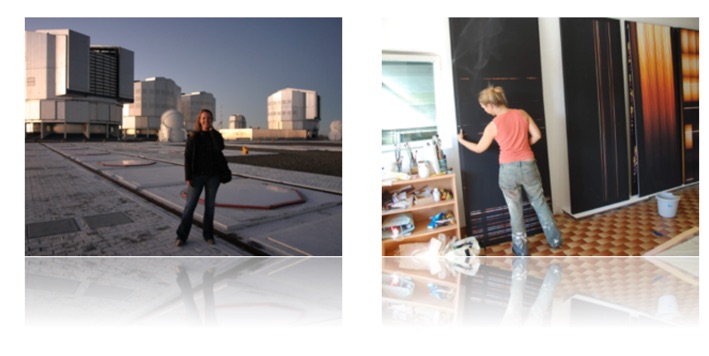About Me

Hello! My name is Ulrike Kuchner and I am a practicing astrophysicist, artist, interdisciplinary researcher, curator and creative producer. I value introspection and dialogue and integrate creative and critical thinking. I believe that empathetic imagination is important for the co-creation of new knowledge and for making sense of it all.
I am professionally trained and qualified in both art and science. In particular, I have a PhD in astrophysics and a BA/MFA in Fine Arts (paintings). Perhaps this doesn’t come as a surprise: the label one would attach to my art practice is that of ArtScience. I make art, I research and I curate, facilitate and produce exhibitions and ArtScience encounters. I publish both in astronomy and in the inter- and transdisciplinary context of ArtScience, am part of the group coordinating the international transdisciplinary network SEADS and co-develop the ARTlab Nottingham, a new incubation and practice as research space for artists-in-residence and Nottingham scientists.
In my scientific research, I study the evolution of galaxies and how structures form in the Universe, such as cosmic filaments and galaxy clusters. I lead the scientific output and practical preparation for the WEAVE Wide-Field Cluster Survey with the upcoming new instrument WEAVE at the William Herschel Telescope in the Canary Islands and actively participate in the readiness of Europe’s next big space telescope, the Euclid Telescope, where I co-lead the Cosmic Web team. To do this, I bridge simulations (specifically, cosmological hydrodynamical simulations as part of the ThreeHundred collaboration) with observations (both spectroscopy and photometry). I am also an active member of the new 4MOST CHANCES survey, which will map many cluster infall regions in the Southern Hemisphere.
In my interdisciplinary research and ArtScience practice, I integrate different approaches and knowledge systems from science and art and aim to improve the balance in collaborations. I join and research the creative process of other art-scientists and science-artists and contribute scientifically/artistically to translate, communicate and create together to build more equitable, creative and satisfactory processes and outputs. I advocate for the value of ambiguity, especially at the stage of defining the problem or question and gathering of information. The communication between practitioners of far-removed disciplines is not a given, which is why a reciprocal interdisciplinarity benefits from an integration across boundaries and decision-making environments.
As an artist, I often use data or methods from my scientific research, which gives me the possibility to detach exploration and understanding from the context of the discipline, its constricting expectations and specific purpose. It offers time for contemplation, a subjective view and greater freedom to make mistakes with empathy, which I experience as liberating. I explore the origins of reality, errors and truth as a way for the beholder to search for personal meaning. How could we ever make meaning of the Universe and its origin, where time and place disconnect from our understanding? For something so overpowering like the beginning of everything, every approach or approximation of an understanding is allowed and indeed, required: poetry, storytelling, music, mathematics, art, physics. Through art, we might get a chance to relate the evolution of 14 billion years to the tiny thing that is the subjective self, to the urgency to sustain our planet in the coming decades and the political and social catastrophes that we create and fight.
